Hyperrhiz 10
Jeffrey Jones, Lighthole
Tymofey Wowk
University of Maryland Baltimore County
Citation: Wowk, Tymofey. “Jeffrey Jones, Lighthole.” Hyperrhiz: New Media Cultures, no. 10, 2013. doi:10.20415/hyp/010.r02
Abstract: Review of Jones, Jeffrey. "Lighthole." Greeting Card. Lighthole. Jeffrey Jones, 8 December 2012. Web. 10 December 2012.
"You were born to be somebody special" (Hallmark card featuring Justin Bieber)
This is a special occasion — your graduation, your anniversary, your birthday — so special that even Justin Bieber notices how special you are. Hallmark, the greeting card giant, is a company who according to their website makes over $4 billion per year, has for sale 49,000 products at any one time, owns and runs a TV channel, produces 10,000 new cards every year, and sells cards in 30 languages in 100 countries around the world. In A Token of My Affection: Greeting Cards and American Business Culture, Barry Shank critiques the relationship of an industry that ties emotions to consumerism and how this marriage structures both how people feel and express their feelings.
The launch of Jeffrey Jones's first online conceptual art collection, "Lighthole", showcases an extensive conversation with the convention and tradition of this industry through their medium of the greeting card. His cards demonstrate interplay between text and images, and offer a distinct alternative to the culturally determined meaning of what a greeting card is supposed to be. Hallmark has largely dominated this conversation, so conceptualism is a fitting new partner who has the potential to impact its direction in the future. Jones's work in the world of ideas through greeting cards gives us an opportunity to now choose for ourselves what up to this point has largely been prescribed for us.
The photographed and uploaded online collection contains 110 cards printed on 100 lb. heavy card stock matte with a whiteness level of 94. 84 cards are 4 ¼ x 5 ½ and 26 cards are 5 x 7. The majority of the collection is text only cards in Helvetica bold font, and the remaining are a mixture of text and images, and image only cards. One thing is certain when viewing the collection in its entirety: this appears to be the antithesis of Hallmark. Many of the text cards show a sharp contrast with Hallmark — like "pretty picture" and "uplifting quote" (Figure 1.1), and "you're so vain" and "you probably think this card is about you" (Figure 1.2) — thereby reversing the culturally accepted norm and expectation of what a greeting card is.
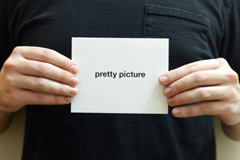
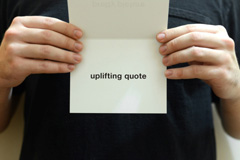
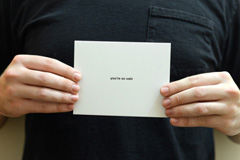
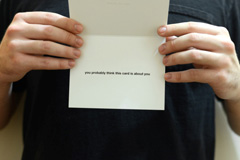
Other text cards are perhaps even more conceptual, such as "nothing (more inside)" (Figure 1.3), and "this is a __ card" (Figure 1.4), both containing a blank inside.
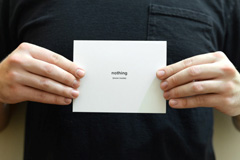

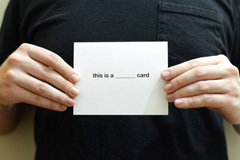

Some are more playful like "three more years!" and "18" (Figure 1.5), stabs at popular culture like the "cardashian" card (Figure 1.6), or portray a darker yet still witty side such as "we're all going to die" and "carry on" (Figure 1.7).
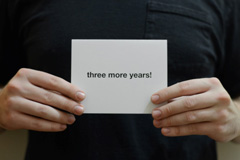
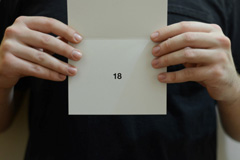

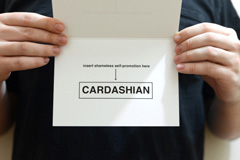
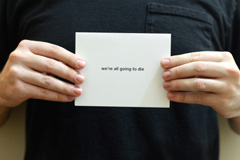
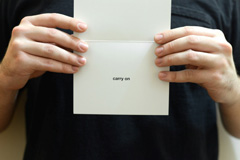
Others mix text and images in a playful fashion, such as the "awkward silence" and "ah, that's better" iphone card (Figure 1.8), the "i miss ewe" (Figure 1.9), the "happy retirement" (Figure 2.1), the "Dirty card" (Figure 2.2), and the "glass half full" (Figure 2.3).
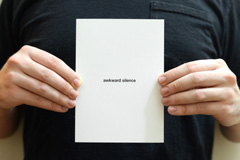
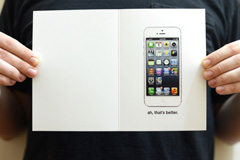



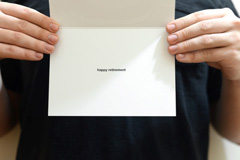

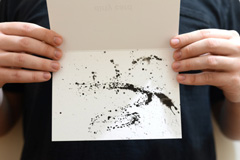


And then there are the image only cards. It seems the text helps explain the concept, whereas the images are less explicit. A boat sailing on the ocean on the outside of one card is capsized on the inside (Figure 2.4), a light turned on in another on the front is turned off on the inside, represented by an all black design (Figure 2.5), or a cute little doggy on the front is replaced by one doing his business on the inside (Figure 2.6) — all of which again contradict our cultural expectations.






There's also the potato/tomato card (Figure 2.7) and the coffee cup/stain card (Figure 2.8) on the playful side, and the all black outside and inside (Figure 2.9) on the more extreme side.

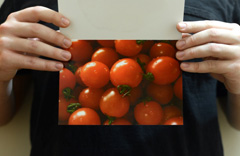

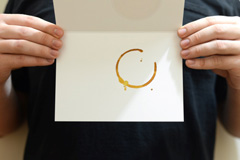

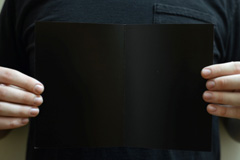
A close reading of "Lighthole" requires attention to the relationship between objects and possible interpretations, and similar to Rene Magritte's 1929 'this is not a pipe', Jones pushes the reader to notice how this process, or coding, operates. The greeting card is therefore the obvious medium to parody the code constructed by Hallmark. Much like other corporate and cultural goliaths like McDonald's, Coca Cola, and Nike, Hallmark spreads their version of American culture to the far corners of the earth. The message Hallmark sends is of aesthetically pleasing pictures and pre-written sentiments to accompany them. The designs ease the burden on the consumer to have to create something original and meaningful to say for the recipient of the card. The only difficult part for the consumer is choosing which card best expresses what he or she doesn't want to put the effort in to write.
Jones in fact recently faced head-on the cultural code stemming from the Hallmark-dictated conception of what a greeting card is. In November, 2012, Jones spoke with a prominent greeting card representative. She told him that as art his line is brilliant and if she owned a gallery, she would showcase his cards as an exhibit immediately. But the cards are too smart, she continued, and the average consumer is too lazy to buy them as greetings cards or would be too confused to figure out on which occasion to give most of them. Her suggestion was to 'dumb them down' to make them available for the mass market. Clearly the apparent naturalization of what a greeting card means, as well as when cards are culturally allowed to be given, controls the entire industry. It remains to be seen how Jones's cards will be viewed by either the art world or the greeting card consumer market, but (perhaps surprisingly), this fits perfectly into what "Lighthole" is trying to accomplish.
Jones's collection in a subversive fashion challenges the greeting card consumer to question the inclination toward laziness in consumption and even to address the issue of what a special occasion or holiday means at all. Most cards in his collection engage the cultural desire for optimism and the entire meaning of 'special' days, not through pessimism of the structure but through parody and thus a conversation of difference. We can call it 'art' or not, say it is or is not a line of greeting cards, or use whatever mental constructs we want (perhaps the simplest example to ask this question is Figure 3.1), but one thing is clear: Jones is giving us an opportunity to snap out of our acceptance of the world of perceived absolutes and enter into a dialectic conversation about what, why, and how meaning is possible. Through the parody of Hallmark, such dialogue for Jones is reminiscent of his time living in a Zen Center in Los Angeles, where he practiced the Zen Koan, or paradoxical questioning process.


Jones's experience at the Zen Center is apparent in his art (greeting cards) now, but this is not some cheery Hallmark-inspired tale of his enlightenment and transcendence. Attachment to our own version of reality and the material objects that accompany it happen in every context, and therefore the need of paradoxical questioning is ever-present for him. Indeed, many of his cards achieve this purpose, mocking Hallmark in the process. But it still is difficult to ascertain whether the greeting card representative was correct in her assumptions. Hallmark's dominance might well exist because of the connection between the (lazy) need of the consumer and the hole filled by their designs. Given the enormous profits Hallmark reaps, the consumer likely is getting exactly what he or she wants, and something outside this seemingly naturalized selection (code) might just as likely be less desired. Whether Jones is making greeting cards or art might not be the issue, as his work clearly fills a hole as well: his might be smaller, trendier, more intellectual, more philosophical or more spiritual. One thing, however, is certain: whether we choose to question this particular cultural code or not, there is a clear path for how to proceed if we are willing to choose it. And this special occasion is now.